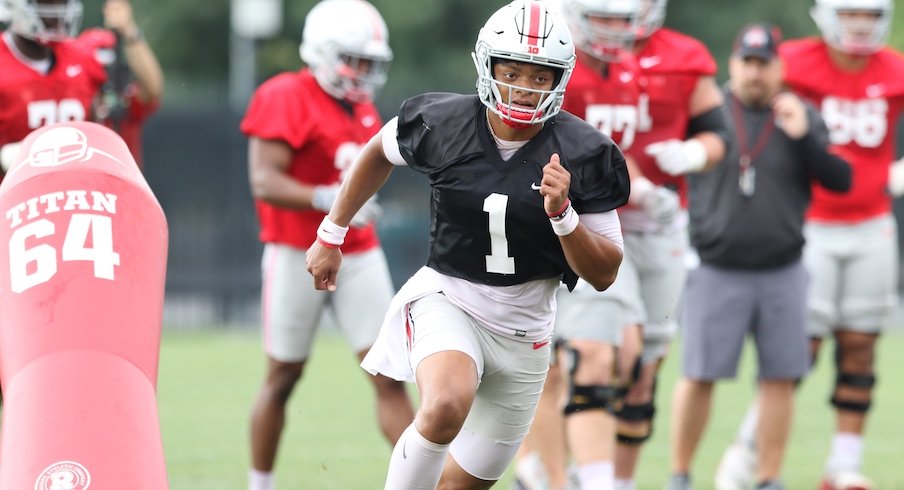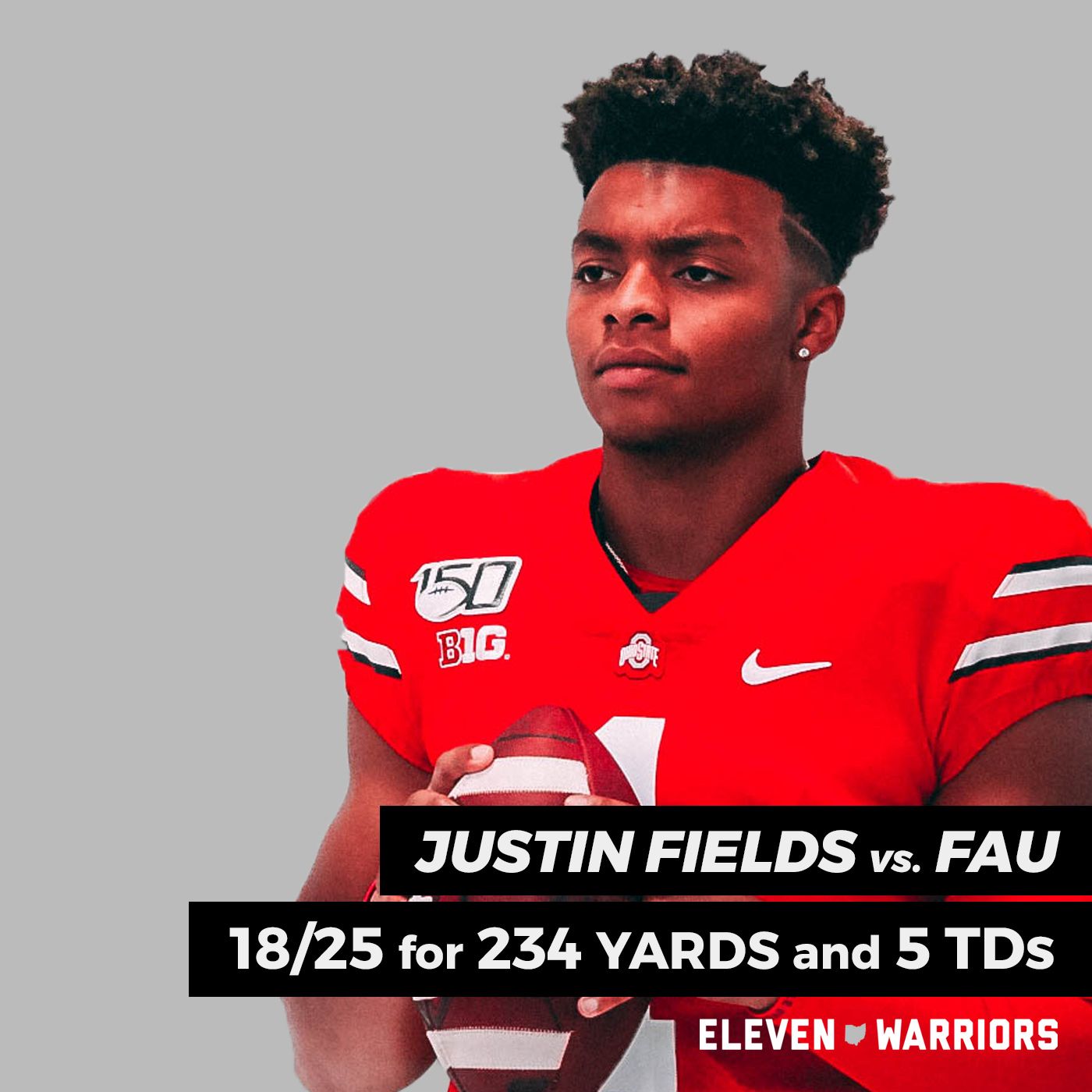HOW JUSTIN FIELDS' SKILLSET, STRENGTHS CHANGE OHIO STATE'S OFFENSE
Colin Hass-Hill on August 20, 2019 at 9:10 am
@chasshill
Email this Article
Share on RedditShare on TwitterShare on Facebook328
43 COMMENTS
Whenever anybody ever described Dwayne Haskins last offseason, they first mentioned his touch as a passer. On the day he signed with Ohio State, Urban Meyer said he
wasn’t sure whether he had ever seen a young quarterback with his fundamentals.
Passing touch and accuracy aren’t the first skills that come to mind when considering how Justin Fields will have an impact as the Buckeyes’ starting quarterback this fall. Rather, they’re two of the bigger looming questions about the Georgia transfer. Justin Fields’ standout attribute, at least at the moment, is his combination of speed and size, along with his raw arm strength.
Haskins and Fields have striking differences in their strengths on first glance, and with a closer look, it’s still hard to avoid noticing them.
Haskins is a 6-foot-3, 231-pound pocket-passing quarterback who makes difficult throws look effortless, avoids most mental mistakes that could lead to turnovers, reads defense quickly to find open receivers and runs a 5.04-second 40-yard dash. Fields is a 6-foot-3, 223-pound bruiser of a runner who clocks a 4.5-second 40-yard dash, has a strong arm, can make things happen when plays break down and is still developing both his decision-making and accuracy.
“THAT WILL BE OUR NEXT CONVERSATION WHEN I SIT DOWN WITH JUSTIN IS, YOU CAN'T GO OUT AND TRY TO BE WHAT DWAYNE WAS IN GAME ONE. YOU CAN'T BE WHAT J.T. BARRETT OR BRAXTON MILLER WAS. YOU HAVE TO BE YOU.”– RYAN DAY
They’re different, and it’s hard not to notice. But on the afternoon that Ryan Day named Fields the starting quarterback, he also said that despite the change at the position, there won’t be anything close to a wholesale change in the offense.
“(The offense is) going to be very, very similar,” Day said. “(Fields') skill set, he has a lot of different things that Dwayne had. He's a little bit more athletic and faster and stronger. He can run. But it will be very similar. We'll see the same type of plays. We're not all of a sudden going to go drastically different. We'll probably emphasize some different packages with him. For the most part it will still be the Ohio State offense.”
He’s not lying. The plays in the playbook won’t really change. The emphasis on quarterbacks needing to know the intricacies of each play won’t dwindle.
But how the offense looks with Fields at quarterback almost certainly will look noticeably different this fall than it did with Haskins a year ago. This goes back to the
bucket system that Day spoke about at the Ohio State coaches clinic in the spring.
During the offseason implementation of the offense, Day and the coaches separate each play concept into what they call “buckets,” teaching all of them. Then, on a given week for a specific game plan, they grab a certain amount of play designs from each bucket that they plan to use against their upcoming opponent. It allows them to not make any drastic changes to the entire offense while changing it up from week to week and between years.
When comparing this year and last year, there likely aren’t many differences between the amount and types of “buckets.” But in order to take advantage of what Fields does well, Day and the coaches this fall will have to rely on buckets of concepts they might not have used as often with Haskins at quarterback. That allows Day to keep what he calls the “Ohio State offense” in tact while also altering the specifics behind how it functions.
“I think you want to cater to the quarterback's natural abilities,” quarterbacks coach Mike Yurcich said in the summer. “Certain guys I think you're going to see weaknesses, and certain guys you're going to see strengths. We believe in playing to the quarterback’s strengths, but at the same time you also have to try to increase where they're weakest. You try to evaluate all those things in the offseason and then at the same time we have to operate the Ohio State offense.”
Fields’ key attribute that Day and Yurcich need to take advantage of is his speed.
While Haskins rarely ran and sometimes looked foolish when he tried, Fields has tree trunk legs that make him look like a running back. He’s bigger and a more physical runner than Braxton Miller, but he’s also faster than J.T. Barrett, who ran a 4.70 40-yard-dash. At Georgia, he only had 42 rushing attempts, but he racked up 266 yards, an average of 6.3 yards per carry.
“He’s different, because I feel like I can put him in that Cam Newton category,” K.J. Hill said. “He’s got some wheels on him. He can fly. So that can open it up for us, his receivers and the whole offense. You know you got to worry about a running quarterback. He’s fast. 4.4, somewhere in there, and plus you got to worry about his arm. So that’s going to open up the offense.”
Chase Young added: “Man, watch out. Watch out. He's done it a few times, especially when we go situation defense, he'll take the ball down and run.”
Given that ability to pick up yards on the ground, especially when plays break down, it would be foolish not to take advantage of Fields’ legs.
But Day and Yurcich also have to be wary of relying on him to run too much. They can’t afford for him to get hurt. If he left the game with an injury, Ohio State would have to turn to either Kentucky transfer Gunnar Hoak or fifth-year Chris Chugunov. Hoak transferred into the program this summer, giving him minimal time to pick up the offense, and Chugunov was brought in with the intention of him being a reserve last year.
“I'm not comfortable with (Fields) taking a lot of hits in the course of a game, for sure,” Day said. “I think that those are all things that are going to be really calculated down to the last carry. Like you said, because he has such a great skill set, you can do a lot of things with him. You have to be smart with that.”
Day separated the runs into two categories.
Fields will have runs into heavy traffic, likely in short-yardage or goal-line situations, in which he could have heavy contact or forceful collisions with linebackers. He’ll also have carries – which could stem from scrambles – that get him into the open field and give him the ability to either slide or get out of bounds, which Day said Oklahoma’s Kyler Murray did well last year.
“That's all part of the plan here in figuring that out for him,” Day said. “But obviously don't want to put him at risk.”
Day doesn't plan to drastically alter his offensive philosophies and has to keep his quarterback healthy. At the same time, though, he wants to allow Fields room to operate with his entire toolset at his disposal.
“You can't try to do too much. You can't try to prove too much,” Day said. “That will be our next conversation when I sit down with Justin is, you can't go out and try to be what Dwayne was in game one. You can't be what J.T. Barrett or Braxton Miller was. You have to be you.”
Fields has to be himself, but Ohio State must also figure out how to allow him to do that while both minimizing collisions and staying within the confines of what the coaches want from the offense.
It’s a delicate balance, and it's one Day can’t afford to mishandle.
https://www.elevenwarriors.com/ohio...YH0RMIi_Q2f7Nddh0oFJgVSmjCLgTVIdT0euTRzGRezII






